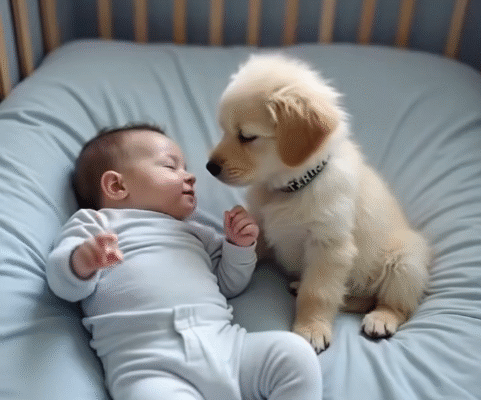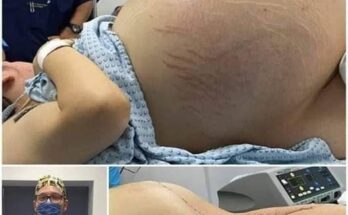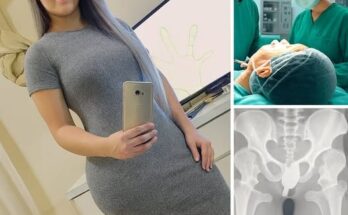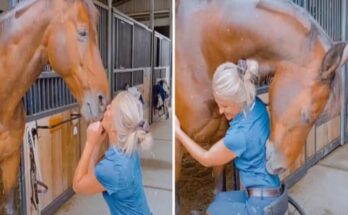The harsh fluorescent lights of Children’s Hospital cast a cold, clinical glow across the consultation room. Dr. Rebecca Hammond’s voice, calm yet irrevocable, shattered the fragile bubble around the Parker family’s world. Sarah Parker’s hands trembled as she cradled her infant son, Noah — his tiny, delicate body feeling impossibly vulnerable in her arms.
“Spinal Muscular Atrophy,” Dr. Hammond repeated gently, but with a weight that crushed the air between them. “It’s a progressive neuromuscular disorder affecting the motor neurons in the spinal cord. Noah has Type 1 — the most severe form.”
Michael Parker sat frozen beside his wife, an engineer by trade but now utterly lost in the flood of medical jargon dismantling their future piece by piece. “What does that mean exactly?” His voice was barely steady, knowing full well the answer would rewrite their lives forever.
With a soft, practiced compassion born from years of delivering heartbreak, Dr. Hammond explained, “Noah’s motor neurons — the nerve cells controlling voluntary muscle movement — are deteriorating. His muscles will weaken progressively, making everyday tasks impossible over time.”
Silence fell like a suffocating shroud. Sarah’s gaze locked onto Noah’s peaceful face, imprinting every detail in her memory: the delicate sweep of his lashes, the gentle rise and fall of his chest, the perfect curl of his tiny fingers. How could something so beautiful be so fragile? So broken?
“Will he ever…” Sarah’s voice faltered, raw with desperation. “Will he ever walk?”
Dr. Hammond shook her head slowly, her eyes filled with sorrow. “Children with Type 1 SMA usually never sit up unassisted, let alone walk. Sadly, most don’t live beyond their second birthday.”
The words struck Sarah like a thunderbolt. She clutched Noah closer, as if her love alone could shield him from the cruel reality. Tears blurred her vision, but she swallowed them back fiercely — not here, not now, not in front of him.
Michael’s analytical mind kicked in, searching for a lifeline. “What can we do? Treatments? Therapies?”
“We’ll focus on supportive care,” Dr. Hammond replied gently. “Physical therapy to keep his muscles flexible, respiratory support as breathing becomes difficult, nutritional care when swallowing weakens. Our goal is to keep him comfortable.”
Comfortable. The word echoed in Sarah’s mind like a bitter irony. How could anything about watching your child slowly lose his ability to move, to breathe, to live be comfortable?
The drive home was heavy with silence. Michael gripped the steering wheel until his knuckles whitened. Sarah sat quietly beside Noah’s car seat, eyes never leaving her son’s sleeping form. Every breath felt sacred, every moment a fragile gift threatening to slip away without warning.
Their once bright, hopeful home — painted in sunny yellows, filled with dreams of first steps and birthday cakes — now felt like a cage. The mobile above Noah’s crib, with its dancing bears and smiling suns, seemed to mock them with its innocent cheerfulness. It would witness only stillness.
That first night stretched endlessly. Sarah sat in the rocking chair, eyes glued to Noah’s fragile body, terrified that closing her eyes even for a second would mean missing a sign — a distress, a crisis, or worst of all, silence.
Michael found her at dawn, her neck stiff, eyes swollen but vigilant. “You need to rest,” he said softly, placing a gentle hand on her shoulder.
She shook her head. “What if something happens? What if he needs me?”
“Then I’ll wake you,” he promised. But they both knew she wouldn’t leave her post. How could any mother turn away when her child’s days might be counted in months, not years?
Weeks blurred into a haze of doctors’ appointments, insurance calls, and endless exhaustion. Sarah became fluent in words she never wanted to know — hypotonia, fasciculations, dysphagia — each a cruel reminder of Noah’s decline.
Friends and family tried to help, leaving casseroles and notes urging “strength” and “faith.” Sarah appreciated the kindness, but food felt meaningless when every breath her son took was a battle.
The hardest part wasn’t the machines or the grim prognosis. It was the silence — the absence of the sounds they had imagined filling their home. No giggles, no cries of joy, no proud “mama” or “dada.” Just the constant hum of monitors and the soft whisper of the nebulizer.
Michael plunged into research, devouring medical journals and clinical trials late into the night, seeking any sliver of hope. He reached out to specialists nationwide, explored experimental treatments, even stem cell therapies abroad — only to find the same devastating truth: no cure, no miracle.
Sarah chose a different path. She focused on now — on making every fleeting moment precious. She sang lullabies constantly, played classical music hoping to spark some response, and read stories aloud even without any sign that Noah heard. She massaged his tiny limbs with all the love and desperation she had, willing her touch to heal where medicine could not.
But hope is fragile, and by Noah’s six-month birthday, it felt as thin as a whisper.
Chapter 2: A Golden Thread of Hope
On a bleak Tuesday afternoon, as Noah fussed weakly and struggled even to hold up his head, Sarah’s scrolling through social media stopped abruptly. She watched a video of a golden retriever therapy dog comforting elderly patients — their faces lighting up with smiles no medication could bring.
A spark ignited within her. Maybe Noah needed a companion. Maybe where science failed, unconditional love could succeed.
Michael was skeptical when she brought it up that evening. “Sarah, we’re barely managing Noah’s care. How could we handle a dog too?”
But Sarah’s mind was made up. “Not a dog,” she insisted. “A puppy. Small. Gentle. A friend.”
That Saturday, despite Michael’s hesitation, they visited the Riverside County Animal Shelter. Sarah’s research pointed her toward golden retrievers — known for their gentle, intuitive nature with children. If any dog could help Noah, it would be a golden.
Margaret, a kind-faced volunteer, led them to the puppies. “Are you sure you’re ready for a puppy?” she asked kindly. “They need a lot of care, especially early on.”
Michael carried Noah’s car seat; Sarah gave a wry smile. “We’re used to sleepless nights.”
Among the playful, fluffy puppies, one caught Sarah’s eye. While his siblings tumbled and yipped wildly, this little one sat quietly in a corner, oversized paws awkwardly folded beneath him. His golden coat was slightly darker, and his deep brown eyes held an unexpected wisdom.
“That’s Max,” Margaret explained. “He’s the runt, the quiet one. He’s been here the longest because most families want the more energetic pups.”
Sarah knelt and extended a finger. Max approached slowly, sniffed, then gently licked her finger — a soft, reverent touch that felt like a lifeline.
“This one,” Sarah said without hesitation.
Michael frowned, uncertain. “Shouldn’t we look around more?”
“This one,” Sarah repeated firmly. Like Noah, Max was small and vulnerable — two souls who needed each other.
The adoption took longer than expected. Margaret asked about their home, their experience with pets. Sarah was honest. “Our son has special needs,” she said quietly, nodding toward Noah’s car seat. “We thought a gentle companion might help.”
Margaret looked at Noah sleeping peacefully amidst the barking dogs and smiled softly. “He’s beautiful,” she said. Then, glancing at Max, who hadn’t moved since their first touch, she nodded. “I think Max might be exactly what you need.”
On the drive home, the house felt lighter for the first time in months. Max, small and curious, settled quietly in his carrier. Noah, as if sensing the change, seemed more alert — tracking movements with eyes brighter than before.
“What if this was a mistake?” Michael whispered. “What if he’s too energetic? What if he disturbs Noah?”
Sarah unbuckled Noah’s car seat with one hand, reached for Max’s carrier with the other. “Then we’ll figure it out. We always do.”
That night was nothing like Sarah expected. Instead of chaos, Max seemed to understand their fragile world. He didn’t run wild or demand attention; he settled quietly beside Noah’s crib, a gentle sentinel.
When Noah began his usual evening fussing, Max approached softly and let out low, comforting rumbles — not barks, not cries, but soothing sounds that seemed to calm Noah’s tiny body.
And then, for the first time in weeks, Noah was still.
Sarah and Michael watched breathless. Noah’s breathing slowed, his fists unclenched, his face softened into peace.
“Is he…?” Michael whispered.
Sarah nodded through tears. “He’s really sleeping.”
That night, for the first time since diagnosis, Sarah and Michael slept more than two uninterrupted hours. They woke to find Max curled quietly on the floor beside Noah’s crib, unwavering in his watch.
Days passed, and a new rhythm formed. Max’s silent presence became a balm — an unspoken comfort no medicine could provide.
But what happened next would challenge everything they believed about healing, hope, and the mysterious bonds that connect hearts in ways no one can explain…
Chapter 3: Patterns in the Night
Three weeks had passed since Max arrived, and with each sleepless night, Sarah’s hope was quietly stretching thinner. It was 2:47 AM — a time she’d memorized by heart, checked obsessively while watching over Noah since his diagnosis. Sleep had become a fleeting luxury, stolen in fragments between monitoring his fragile breaths and repositioning him to prevent sores.
But tonight was different.
As Sarah sat in the rocking chair beside Noah’s crib, eyes heavy but alert, she noticed Max was awake—alert and purposeful. The golden puppy, usually a sound sleeper through the darkest hours, had settled beside Noah with an intensity Sarah hadn’t seen before. And then she realized: Max wasn’t just lying there for comfort. He was working.
No other word fit what she saw unfolding. Max’s tiny snout moved deliberately, nudging Noah’s body with focused precision. First, the left hand—soft pressure against the palm, gentle strokes along the fingers. Then the right hand, mirroring the same careful pattern.
Sarah leaned in, her heart pounding. Was it her exhaustion playing tricks, or was Max actually doing something?
Then Max shifted to Noah’s feet, pressing gently, and Sarah’s breath caught. There—a barely noticeable twitch in Noah’s right big toe.
Her eyes widened. Children with spinal muscular atrophy didn’t move like that. Not voluntarily. Not at all. The doctors had made that painfully clear.
But there it was again—tiny flexes, subtle yet unmistakable—each time Max pressed his nose against Noah’s foot.
Sarah’s hands flew to her mouth, stifling a gasp. She froze, afraid that any sound might shatter this fragile miracle. Max worked like a skilled therapist, moving systematically from one part of Noah’s body to another, each touch purposeful.
When Michael found her the next morning, still rocking and barely coherent from exhaustion, she grabbed his shoulder with urgency.
“You have to see this,” she whispered. “Last night… Max was helping Noah. I think… Noah moved.”
Michael rubbed his eyes, half-awake. “Sarah, you need rest—”
“I’m not imagining this,” she interrupted, though a flicker of doubt lingered in her voice. Was it real? Or was her desperate heart manufacturing hope?
Determined to find out, Sarah set up her laptop beside the crib that very evening, pointing the camera to capture everything. If Max’s strange therapy was real, it needed proof. And if it wasn’t, she had to face that truth too.
The next morning, trembling, Sarah watched the footage. The timestamp confirmed it: starting exactly at 2:30 AM, Max’s ritual began and lasted nearly an hour. The pattern was undeniable—targeted, rhythmic pressure, pauses, then repetition.
And Noah responded.
Not with grand gestures, but subtle, consistent movements—a slight curl of fingers, a faint flex of toes, the smallest shift of a leg.
Michael joined her by the screen, eyes glued to the evidence. After watching it three times, he whispered, “This… this shouldn’t be possible.”
“But it is,” Sarah said. “It’s happening.”
His logical mind struggled to keep pace. “Maybe reflexes. Spasms.”
“Look at the timing,” Sarah insisted. “Every movement follows Max’s touch. It’s cause and effect.”
Over the next two weeks, they watched as the pattern grew stronger. What started as tiny twitches evolved into deliberate grasps. Noah’s fingers curled around Max’s paw, holding on before slowly letting go.
Sarah documented every detail — the timing, the movements, the progression — creating charts and graphs to visualize what felt like a miracle.
Then, one unforgettable Thursday night, Noah initiated the connection himself. His hand reached out, awkward but intentional, to stroke Max’s fur.
Tears streamed down Sarah’s face as she watched her son—once thought paralyzed—touch his puppy with clear purpose. Michael held her shoulder silently, both afraid to break the fragile spell.
“We have to tell someone,” Sarah said, her voice steady despite the storm inside her.
Michael nodded slowly. “But who will believe a puppy’s therapy can trigger movement in advanced SMA? It sounds impossible.”
“Then we’ll make them believe,” Sarah said fiercely. “We’ll show them everything.”
They had no idea their choice would ignite a global storm — challenging medical dogma, redefining hope, and revealing truths about healing science barely dared to explore.
A battle was brewing—between hope and skepticism, between the miraculous and the accepted—centered on one small golden puppy and the family who refused to give up.
Chapter 4: The Medical Establishment Responds
Dr. Rebecca Hammond had been a pediatric neurologist for over fifteen years—enough time to recognize the raw desperation in parents’ eyes when hope clings to the impossible. The Parkers sat across from her desk, their laptop open, faces flushed with excitement that felt painfully out of place against the cold reality of their son’s diagnosis.
“Doctor, you have to see this,” Sarah urged, turning the screen toward her. “We’ve been recording Noah at night, and Max—our puppy—has been doing something incredible.”
Dr. Hammond let out a quiet sigh, the kind born of too many similar encounters. She’d witnessed this before: loving parents grasping for signs, reading miracles into twitching muscles. It was heartbreaking—and, sadly, all too common. Denial, she knew, was often the last refuge of those facing the unthinkable.
The video played. Dr. Hammond watched with clinical detachment as a golden retriever nestled beside the infant, gently nudging and touching. She observed the baby’s faint movements—the tiny contractions the Parkers interpreted as responses to Max’s actions.
“Mrs. Parker, Mr. Parker,” she began softly as the video ended, “I understand your hope. You want to believe something, anything, can help Noah. But what you’re seeing are involuntary muscle spasms—reflexes common in children with SMA.”
Sarah’s hopeful expression faltered. “But the timing… the consistency—”
“That can be explained by the disease’s progression,” Dr. Hammond interrupted gently but firmly. “Sometimes before motor function fades entirely, there are brief bursts of muscle activity. It doesn’t mean he’s improving or responding to therapy.”
Michael leaned in, determination flickering in his eyes. “But what if we’re right? What if there’s something here we don’t understand? Shouldn’t it be investigated?”
Her tone softened, sympathy breaking through professionalism. “The science on spinal muscular atrophy is clear. The motor neurons controlling voluntary movement are irreparably damaged. No external stimulation can regenerate them.”
Sarah pressed on, “What about neuroplasticity? The brain’s ability to rewire itself?”
“Neuroplasticity has its limits,” Dr. Hammond said. “Not in severe motor neuron degeneration. I’m sorry, but I see loving parents hoping for a miracle, not evidence of therapeutic benefit.”
The appointment ended with Dr. Hammond gently suggesting support groups to help the Parkers cope. As they left, she felt a quiet satisfaction in delivering a realistic assessment—but also a pang of sadness, haunted by the hope she had to dim.
What she couldn’t know was that her dismissal only fueled their determination. Driving home in silence, Sarah’s mind raced.
“We need a second opinion,” she said quietly.
Michael nodded. “And a third. And a fourth if we have to.”
Over the next two weeks, they sought out five specialists across three states. The verdicts echoed each other: polite skepticism, gentle reminders about SMA’s progression, subtle hints that they were reading too much into random muscle twitches.
Dr. Marcus Rodriguez of Johns Hopkins was bluntest. “I reviewed your footage,” he said during a video call. “No scientific basis exists for a dog to regenerate motor neurons. What you’re seeing is likely myoclonus—jerky involuntary muscle spasms common in neuromuscular diseases.”
Dr. Patricia Weinstein, a pediatric rehab expert, offered a kinder perspective. “Animal-assisted therapy can ease emotional strain,” she admitted. “A calm pet can reduce stress and improve life quality—but it won’t reverse neurological damage.”
Frustration mounted. Doctors dismissed their evidence without truly looking. They were stuck in charts and textbooks; Sarah and Michael held proof right in front of them.
Then Michael suggested something new. “We need indisputable data. Heart rate monitors. Muscle tension measurements. Multiple camera angles.”
Sarah threw herself into this with relentless focus, borrowing sports medicine equipment, tracking Noah’s vitals and movements through every midnight session with Max.
The results stunned them. Noah’s heart rate stabilized consistently during Max’s visits. EMG readings showed clear muscle responses timed precisely with Max’s touches. Joints once paralyzed slowly gained range of motion.
With new data in hand, Sarah reached beyond traditional medicine—connecting with alternative practitioners, veterinary behaviorists, and researchers studying the human-animal bond.
Dr. Jennifer Martinez, a veterinary behaviorist at UC Davis, took particular interest. “I’ve seen extraordinary interspecies communication,” she said during a long call. “While I can’t medically explain this, dogs have sensory abilities humans barely understand.”
Dr. Martinez introduced them to Dr. Evelyn Carter, a researcher with decades of experience in animal-assisted neurological rehab. Dr. Carter’s response was cautious but intrigued.
“Your documentation is unusually thorough,” she wrote. “Though skeptical, I find the patterns you’ve identified worthy of investigation. Would you allow me to observe these interactions firsthand?”
Sarah’s reply was immediate and hopeful. For the first time since Noah’s diagnosis, someone in medicine was listening.
Dr. Carter’s visit was set for the following week. Sarah spent the days before in tense anticipation—this felt like their last chance to prove a miracle was unfolding in their home. If Dr. Carter dismissed it too, where would they turn next?
The night before her arrival, Sarah sat beside Noah’s crib, watching Max begin his ritual at precisely 2:30 AM. The puppy’s dedication never wavered—methodical, patient, gentle.
“Tomorrow,” Sarah whispered to Max, stroking his golden fur, “someone finally sees what we see. Tomorrow, maybe we find answers.”
Max looked up with knowing brown eyes—as if he understood the weight of the moment—then returned to his quiet work, nudging Noah’s tiny hand until the fingers curled around his paw in their nightly dance of hope and healing.
Chapter 5: The Breakthrough
Dr. Evelyn Carter arrived at the Parker home on a crisp October morning, carrying the quiet confidence of someone who had spent thirty years pushing against the boundaries of conventional medicine. Renowned in the world of animal-assisted therapy, her research was cited globally—but even she admitted to feeling skeptical about what she was about to witness.
“I want to be clear about my expectations,” she told Sarah and Michael as they gathered in the living room. “I’ve reviewed your documentation—it’s impressively thorough. But extraordinary claims require extraordinary evidence. I’m here to observe scientifically, not to confirm any conclusions beforehand.”
Sarah nodded, grateful for the candor. After weeks of dismissive consultations, this was the first person willing to truly look.
Noah lay nearby in his portable crib, alert and seemingly aware of the new presence. Max sat close, eyes fixed on Dr. Carter with the careful scrutiny dogs reserve for strangers in their territory.
“Tell me about Max’s background,” Dr. Carter requested, pulling out a recorder. “Age, training, prior exposure to medical settings or special needs individuals?”
“He’s four months old,” Michael replied. “We adopted him from a shelter when he was eight weeks. No training. The shelter said he was the quiet one—less playful than his siblings.”
Dr. Carter took notes. “And when did this behavior start?”
Sarah told the story—the first night Max soothed Noah’s distress when nothing else could. She described how the interactions grew more complex, and Noah’s responses more pronounced.
“What you’re describing implies Max understands anatomy, neurological pathways, therapeutic methods,” Dr. Carter said thoughtfully. “Even trained therapy dogs operate under human direction. They don’t independently develop treatment routines.”
“We know how unbelievable it sounds,” Sarah said. “But every night for six weeks, it’s the same pattern—with the same results.”
Dr. Carter spent the day observing the household. She noted Max’s unusual focus for a puppy so young. “Most dogs this age are easily distracted and playful,” she confided to Michael. “Max seems to sense Noah’s fragility in a way I’ve rarely seen.”
That night, she set up professional monitoring alongside the Parkers’ equipment—tracking Noah’s vital signs, brain activity, and muscle responses throughout Max’s session.
At 11 PM, Dr. Carter positioned herself in the nursery, watching Noah’s crib. Sarah and Michael waited downstairs, giving space for observation without parental presence.
Hours passed quietly. Noah slept fitfully, typical for his condition. Max dozed beside the crib, alert only to check in on his charge.
Then, at exactly 2:28 AM, Max stirred.
Dr. Carter watched as the puppy moved with deliberate purpose. No playful puppy antics—this was clinical precision. Max approached Noah, his nose gently pressing against the infant’s left palm.
Instantly, Dr. Carter’s monitors showed changes: Noah’s heart rate stabilized, brain waves shifted, and muscle activation appeared in response to Max’s touch.
“Impossible,” she whispered, leaning closer to her readings.
Max continued systematically: hand, arm, shoulder—each contact triggering measurable muscle responses from Noah’s paralyzed nervous system. Max paused regularly, allowing time for neurological processing before moving on.
At Noah’s feet, Dr. Carter held her breath. The EMG sensors tracked muscle activity in areas deemed completely unresponsive by all prior medical assessments.
Max’s tongue touched Noah’s right foot.
The monitors erupted with signals—clear, coordinated voluntary muscle contractions. Not spasms, not reflexes. Real responses.
“This can’t be happening,” she muttered, stunned but unable to deny the data.
For forty-five minutes, Dr. Carter watched Max’s masterful routine, recording neurological activity impossible in advanced spinal muscular atrophy.
When Max settled down, Dr. Carter remained silent, absorbing a discovery that challenged decades of medical consensus.
At dawn, she emerged to find Sarah and Michael waiting anxiously.
“Well?” Sarah whispered.
Dr. Carter set down her equipment and looked them in the eye. “I don’t know how, and I don’t know why—but that puppy is triggering neurological responses that should be impossible given Noah’s condition.”
Sarah nearly collapsed with relief. Michael caught her, his face a mixture of vindication and awe.
“You believe us,” Sarah breathed.
“I believe the data,” Dr. Carter corrected. “And it suggests Max is accessing neural pathways medicine thought permanently lost.”
She opened her laptop, showing them graphs from the night’s recordings—neural activity precisely linked to Max’s interventions.
“This changes everything,” she said. “If replicable, these findings could rewrite our understanding of neuroplasticity, regeneration, and recovery in diseases once deemed irreversible.”
Michael found his voice. “What happens now?”
Dr. Carter packed with renewed energy. “We document everything. We bring in more experts. Design controlled studies. And prepare to challenge entrenched beliefs.”
Sarah knelt beside Max, who padded into the kitchen, tail wagging for breakfast. “Did you hear that, buddy? You’re going to help change the world.”
Max licked her face, blissfully unaware his quiet work was on the cusp of revolutionizing medicine, hope, and the extraordinary bonds between species.
But as excitement swelled, none could foresee the challenges and crises that awaited—testing the limits of Max’s mysterious gift.



